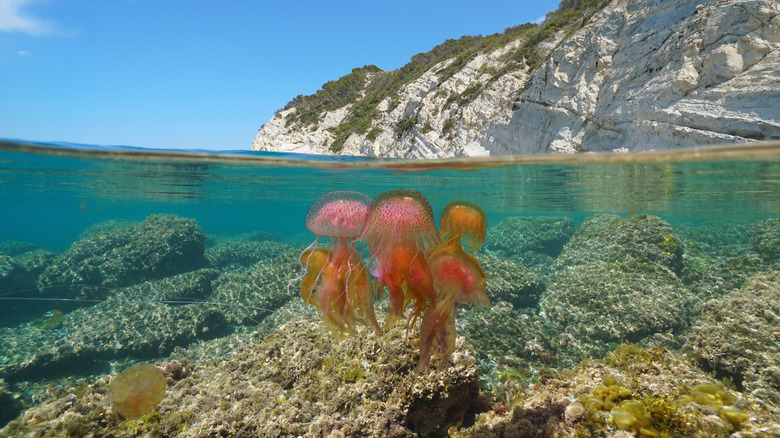Watch Out For Jellyfish When Swimming At This Beautiful European Coastal Region
The Costa del Sol, a stunning 93-mile stretch of coastline in southern Spain, is renowned for its beautiful landscapes, vibrant culture, and 325 days of sunshine, attracting millions of visitors from all over the world. The tourism pleasures of the region include luxury resorts; cultural attractions; leisure facilities; and, of course, stunning shorelines. However, amidst all this coastal temptation, there is one thing, or rather, tons and tons of things, that beachgoers should be careful of — jellyfish.
Costa del Sol, translating to "Coast of the Sun," is a part of the Andalusian coastline in Spain, extending along the province of Málaga and beyond. It's known for its mild climate and long, sun-drenched beaches. From the luxurious Marbella to the historic Málaga, each town along the Costa del Sol offers unique experiences. Whether it's the glitzy nightlife, charming old towns, or the serene Mediterranean Sea, the region offers something for everyone. But in recent years, Costa del Sol has seen an increase in jellyfish populations.
This surge is not unique to this region; it's a troublesome phenomenon occurring in many parts of the world. Scientists attribute this to several factors, including climate change and human activity. Warmer seas provide a more hospitable environment for jellyfish, and the reduction of their predators due to overfishing allows their populations to grow relatively unchecked. Beyond these favorable conditions, jellyfish are notoriously resilient. They've been around for over 500 million years and some species have near-immortal superpowers, need very little oxygen, and reproduce exponentially.
Types of jellyfish at Costa del Sol
The most common jellyfish species found along the shores of Costa del Sol is the Pelagia noctiluca, also known as the "mauve stinger." These are easily recognizable by their pinkish color and glowing presence at night. While their sting is usually not dangerous, it can cause discomfort, skin rashes, and allergic reactions in some people. Other species, such as the Rhizostoma pulmo and Rhizostoma luteum, are also spotted occasionally. They are much larger but less harmful.
It should go without saying that if you see a jellyfish of any size, shape, or color in the waters or washed up on the beach — do not touch it. Unfortunately, this adds a layer of paranoia that no one wants on their vacation, but this is the present reality. "I've been coming to the Costa del Sol for 20 years, and this has never happened before. If you want to take your kids into the sea around here, you have to bring a net, it's that bad," expressed one holidaymaker in an interview with The Sun.
Local authorities in Costa del Sol have taken measures to deal with the problem and ensure the safety and comfort of beachgoers. The first line of defense is beach warning flags to inform visitors about the presence of jellyfish. A yellow or red flag with an additional white flag that features an image of a jellyfish indicates their presence. In some areas, protective nets are installed to prevent jellyfish from getting too close to the shore.
What to do if you get stung by a jellyfish
In the case of a sting, the recommended first aid steps are not to pee on it, as the myth goes. Instead, rinse the affected area with salt water (not fresh water, as it can worsen the sting). Apply vinegar to neutralize the venom and try to scrape off any stingers using a fine object. Above all, seek medical help if the reaction seems severe or the sting covers a large body area. Lifeguards on the beach are ready to assist anyone who might be stung. Regional governments, tourist offices, and local apps like InfoMedusa provide information about jellyfish, including safety tips and real-time updates.
Jellyfish season on the Costa del Sol typically occurs during the warmer months, usually from late spring to early autumn, peaking in the summer. This period generally ranges from June to September — which sadly coincides with peak tourist season. The warmer water temperatures during these months create a more conducive environment for jellyfish to thrive and move closer to the shoreline.
However, the presence of jellyfish is also influenced by other volatile factors such as water currents, winds, and changes in the marine ecosystem. This means that jellyfish blooms can vary from year to year or, worse, be ever-present the entire year. Although jellyfish are a valid and frustrating concern, visitors can still enjoy the beauty of this European coastal region by being responsible beachgoers and taking the necessary precautions to avoid unpleasant, gelatinous encounters.


